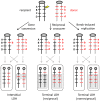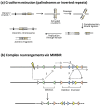Mitotic Recombination and Adaptive Genomic Changes in Human Pathogenic Fungi
- PMID: 31703352
- PMCID: PMC6895784
- DOI: 10.3390/genes10110901
Mitotic Recombination and Adaptive Genomic Changes in Human Pathogenic Fungi
Abstract
Genome rearrangements and ploidy alterations are important for adaptive change in the pathogenic fungal species Candida and Cryptococcus, which propagate primarily through clonal, asexual reproduction. These changes can occur during mitotic growth and lead to enhanced virulence, drug resistance, and persistence in chronic infections. Examples of microevolution during the course of infection were described in both human infections and mouse models. Recent discoveries defining the role of sexual, parasexual, and unisexual cycles in the evolution of these pathogenic fungi further expanded our understanding of the diversity found in and between species. During mitotic growth, damage to DNA in the form of double-strand breaks (DSBs) is repaired, and genome integrity is restored by the homologous recombination and non-homologous end-joining pathways. In addition to faithful repair, these pathways can introduce minor sequence alterations at the break site or lead to more extensive genetic alterations that include loss of heterozygosity, inversions, duplications, deletions, and translocations. In particular, the prevalence of repetitive sequences in fungal genomes provides opportunities for structural rearrangements to be generated by non-allelic (ectopic) recombination. In this review, we describe DSB repair mechanisms and the types of resulting genome alterations that were documented in the model yeast Saccharomyces cerevisiae. The relevance of similar recombination events to stress- and drug-related adaptations and in generating species diversity are discussed for the human fungal pathogens Candida albicans and Cryptococcus neoformans.
Keywords: Candida; Cryptococcus; DSB repair; adaptation; asexual reproduction; gene rearrangements; genome diversity; microevolution; mitotic recombination; pathogenic fungi.
Conflict of interest statement
The authors declare no conflicts of interest.
Figures





Similar articles
-
The Mechanisms of Mating in Pathogenic Fungi-A Plastic Trait.Genes (Basel). 2019 Oct 21;10(10):831. doi: 10.3390/genes10100831. Genes (Basel). 2019. PMID: 31640207 Free PMC article. Review.
-
Identification of Recessive Lethal Alleles in the Diploid Genome of a Candida albicans Laboratory Strain Unveils a Potential Role of Repetitive Sequences in Buffering Their Deleterious Impact.mSphere. 2019 Feb 13;4(1):e00709-18. doi: 10.1128/mSphere.00709-18. mSphere. 2019. PMID: 30760617 Free PMC article.
-
The Genome of the Human Pathogen Candida albicans Is Shaped by Mutation and Cryptic Sexual Recombination.mBio. 2018 Sep 18;9(5):e01205-18. doi: 10.1128/mBio.01205-18. mBio. 2018. PMID: 30228236 Free PMC article.
-
Sexual reproduction of human fungal pathogens.Cold Spring Harb Perspect Med. 2014 Aug 1;4(8):a019281. doi: 10.1101/cshperspect.a019281. Cold Spring Harb Perspect Med. 2014. PMID: 25085958 Free PMC article. Review.
-
Unisexual reproduction drives meiotic recombination and phenotypic and karyotypic plasticity in Cryptococcus neoformans.PLoS Genet. 2014 Dec 11;10(12):e1004849. doi: 10.1371/journal.pgen.1004849. eCollection 2014 Dec. PLoS Genet. 2014. PMID: 25503976 Free PMC article.
Cited by
-
Candida and Candidiasis-Opportunism Versus Pathogenicity: A Review of the Virulence Traits.Microorganisms. 2020 Jun 6;8(6):857. doi: 10.3390/microorganisms8060857. Microorganisms. 2020. PMID: 32517179 Free PMC article. Review.
-
Characterization of systemic genomic instability in budding yeast.Proc Natl Acad Sci U S A. 2020 Nov 10;117(45):28221-28231. doi: 10.1073/pnas.2010303117. Epub 2020 Oct 26. Proc Natl Acad Sci U S A. 2020. PMID: 33106418 Free PMC article.
-
Sexual reproduction is the null hypothesis for life cycles of rust fungi.PLoS Pathog. 2022 May 26;18(5):e1010439. doi: 10.1371/journal.ppat.1010439. eCollection 2022 May. PLoS Pathog. 2022. PMID: 35617196 Free PMC article.
-
Genome-wide analysis of heat stress-stimulated transposon mobility in the human fungal pathogen Cryptococcus deneoformans.Proc Natl Acad Sci U S A. 2023 Jan 24;120(4):e2209831120. doi: 10.1073/pnas.2209831120. Epub 2023 Jan 20. Proc Natl Acad Sci U S A. 2023. PMID: 36669112 Free PMC article.
-
Drivers of diversification in fungal pathogen populations.PLoS Pathog. 2024 Sep 12;20(9):e1012430. doi: 10.1371/journal.ppat.1012430. eCollection 2024 Sep. PLoS Pathog. 2024. PMID: 39264909 Free PMC article. Review.
References
-
- Forche A., Cromie G., Gerstein A.C., Solis N.V., Pisithkul T., Srifa W., Jeffery E., Abbey D., Filler S.G., Dudley A.M., et al. Rapid phenotypic and genotypic diversification after exposure to the oral host niche in Candida albicans. Genetics. 2018;209:725–741. doi: 10.1534/genetics.118.301019. - DOI - PMC - PubMed
-
- Chen Y., Farrer R.A., Giamberardino C., Sakthikumar S., Jones A., Yang T., Tenor J.L., Wagih O., Van Wyk M., Govender N.P., et al. Microevolution of serial clinical isolates of Cryptococcus neoformans var. grubii and C. gattii. mBio. 2017;8:e00166-17. doi: 10.1128/mBio.00166-17. - DOI - PMC - PubMed
Publication types
MeSH terms
Grants and funding
LinkOut - more resources
Full Text Sources
Molecular Biology Databases

